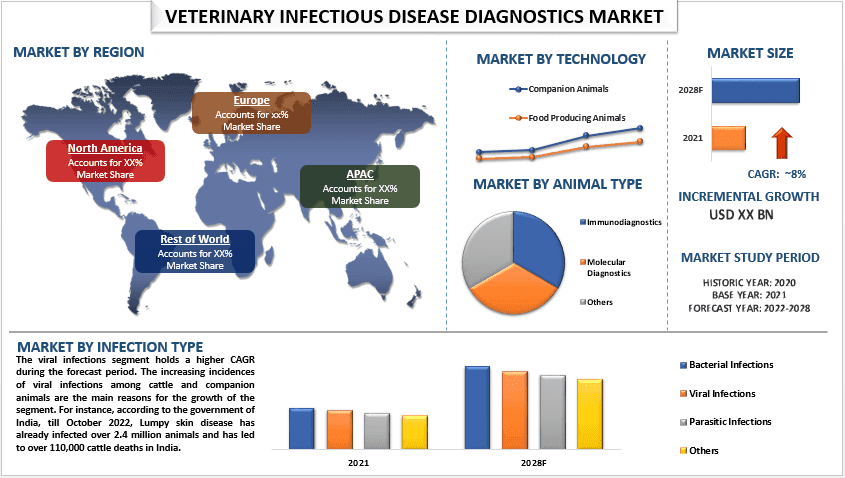
Veterinary Infectious Disease Diagnostics Market Analysis 2028
Infectious diseases are disorders caused by organisms such as bacteria, viruses, fungi, or parasites. The frequently occurring infectious diseases in animals are avian influenza virus and rabies virus. The diagnosis of infectious diseases is extremely difficult owing to the lack of symptoms in the animals. Therefore, huge research has been done in the sector, thus driving the growth of the market. Moreover, the rising adoption of animals and the increasing prevalence of infectious diseases among them are attributed to the market growth of the veterinary infectious disease diagnostics market. For instance, according to the Centers for Disease Control (CDC), Scientists estimate that more than 6 out of every 10 known infectious diseases in people can be spread from animals, and 3 out of every 4 new or emerging infectious diseases in people come from animals.
The Veterinary Infectious Disease Diagnostics Market is expected to grow at a steady rate of around 8% owing to the increasing prevalence of infectious diseases that can also infect human beings. For instance, salmonella infection bacterial disease that affects the intestinal tract. This infection can transmit to humans from animals and can cause salmonellosis.
𝐓𝐨 𝐆𝐞𝐭 𝐈𝐧𝐬𝐢𝐠𝐡𝐭𝐟𝐮𝐥 𝐑𝐞𝐬𝐞𝐚𝐫𝐜𝐡, 𝐑𝐞𝐪𝐮𝐞𝐬𝐭 𝐏𝐃𝐅 𝐂𝐨𝐩𝐲 – https://univdatos.com/get-a-free-sample-form-php/?product_id=35466
According to UnivDatos Market Insights (UMI)’ research report “Global Veterinary Infectious Disease Diagnostics Market”, the market is expected to witness robust growth during the forecast period (2022-2028). This is mainly due to the high healthcare investment and increasing animal population for food products.
Based on the technology, the market has been categorized into immunodiagnostics, molecular diagnostics, and others. Among them, the molecular diagnostics category is to grow at a considerable rate during the forecast period. With the developments in the farm animal sector, the demand for fast and reliable diagnostic techniques such as reverse transcriptase PCR has increased which is responsible for the growth of molecular diagnostics.
Based on the animal type, the market has been categorized into companion animals and food-producing animals. Among them, the food-producing animals segment held the dominant share in 2020. The increasing population of livestock animals for food production attributes to the dominant share of the segment. For instance, as per the New Zealand government stats, dairy cattle numbers increased by 82 percent nationally from 3.4 million to 6.3 million.
𝐓𝐨 𝐆𝐞𝐭 𝐈𝐧𝐬𝐢𝐠𝐡𝐭𝐟𝐮𝐥 𝐑𝐞𝐬𝐞𝐚𝐫𝐜𝐡, 𝐑𝐞𝐪𝐮𝐞𝐬𝐭 𝐏𝐃𝐅 𝐂𝐨𝐩𝐲 – https://univdatos.com/get-a-free-sample-form-php/?product_id=35466
Based on the infection type, the market has been categorized into bacterial infections, viral infections, parasitic infections, and others. Among them, the viral infections segment holds a higher CAGR during the forecast period. The increasing incidences of viral infections among cattle and companion animals are the main reasons for the growth of the segment. For instance, according to the government of India, till October 2022, Lumpy skin disease has already infected over 2.4 million animals and has led to over 110,000 cattle deaths in India.
North America to witness extensive growth
For a better understanding of the market adoption of the veterinary infectious disease diagnostics industry, the market is analyzed based on its worldwide presence in the countries such as North America (U.S., Canada, Rest of North America), Europe (Germany, U.K., France, Spain, Italy, Rest of Europe), Asia-Pacific (China, Japan, India, Rest of Asia-Pacific), Rest of World. North America is anticipated hold a dominant market share in 2020. This is mainly due to the initiative taken by governmental organizations, higher adoption of pets, and favorable pet insurance policies. For instance, as per NAPHIA’s 2022 State of the Industry Report, more than 4.41 million pets were insured in North America in 2021, up from 3.45 million in 2020.
For More Informative Information, Please Visit Us – https://univdatos.com/report/veterinary-infectious-disease-diagnostics-market/
According to UnivDatos Market Insights (UMI)’, the key players with a considerable market share in the Veterinary Infectious Disease Diagnostics market are Abbott; F. Hoffmann-La Roche Ltd; BIOMÉRIEUX; Danaher; Quidel Corporation; QIAGEN; Co-Diagnostics, Inc.; Biocartis; Meridian Bioscience, Inc.; and Thermo Fisher Scientific
“Global Veterinary Infectious Disease Diagnostics Market” provides comprehensive qualitative and quantitative insights on the industry potential, key factors impacting sales and purchase decisions, hotspots, and opportunities available for the market players. Moreover, the report also encompasses the key strategic imperatives for success for competitors along with strategic factorial indexing measuring competitors’ capabilities on different parameters. This will help companies in the formulation of go-to-market strategies and identifying the blue ocean for its offerings.
Market Segmentation:
1. By Technology (Immunodiagnostics, Molecular Diagnostics, and Others)
2. By Animal Type (Companion Animals and Food-Producing Animals)
3. By Infection Type (Bacterial Infections, Viral Infections, Parasitic Infections, and Others)
4. By Region (North America, Europe, Asia-Pacific, Rest of the World)
5. By Company (BIOMÉRIEUX; Heska Corporation; IDEXX; Innovative Diagnostics; INDICAL BIOSCIENCE GmbH; Neogen Corporation; Randox Laboratories Ltd.; Thermo Fisher Scientific; Virbac.; and Zoetis)
Key questions answered in the study:
1. What are the current and future trends in the global veterinary infectious disease diagnostics industry?
2. How the industry has been evolving in terms of technology, animal type, and infection type?
3. How the competition has been shaping across the countries followed by their comparative factorial indexing?
4. What are the key growth drivers and challenges for the global veterinary infectious disease diagnostics industry?
5. What is the customer orientation, purchase behavior, and expectations from the global suppliers across various region and countries?
Appreciate the creator